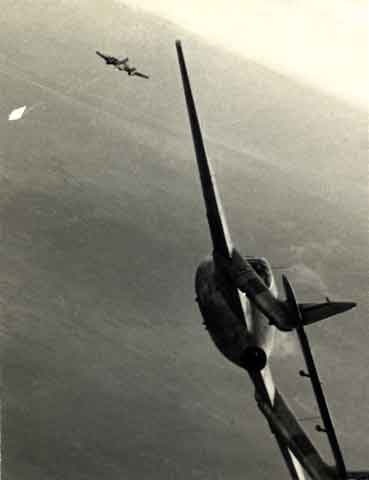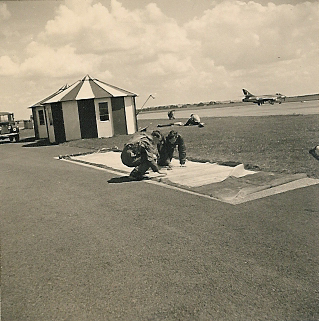|
Gunnery on the Flag at Armament Practice Camp Sylt By Mac McLelland and Chris Stone |
||
|
Fantastic shot, by kind permission of Mac McLelland, that sums up everything about Flag Gunnery at Sylt. Fighter squadrons of all NATO Nations in 2ATAF had to spend about one month at least once a year, sometimes more often if they were lucky, to practice live firing on the gunnery ranges out over the North Sea, just West of the Island of Sylt. The targets would be towed at heights, usually varying between 15,000 and 20,000+ feet AMSL, by Meteors flying at a speed of 180 knots. Firing aircraft would start their attack from a "perch" position on a parallel course to the target, and about 3,000feet above, and 3,000 yards abreast of the Meteor. A hard level turn into the target would then be made, reversing at the 90° position and diving down into a curve of pursuit towards the target. In the early days, Vampires and Venoms would aim to fire with their gyro gunsights set at a 'pegged' range of around 250 yards. With the advent of the Hunter, radar ranging enabled firing accuracy over a wider range bracket. A metal reflector was attached to the banner's spreader bar to assist the radar locking on to the target, and generally this would occur at a range of about 3,000 feet. Then it was a case of steady tracking with the pipper on the bullseye and give it a short burst at about 1,000 feet. Judging range was much a matter of relative size ratio of the pipper to banner width. The ideal Hunter speed at open fire range was about 360 knots, and 10° flap greatly helped steady things in the tight pursuit curve. Mac says on his site: "This is how we used the ranges at Sylt. The white nylon banner, 30 feet long by 6 feet tall, is being towed by a Meteor VIII. The two seat Vampire T11, (we had no two seater Venoms on 266 Sqn), is being used for instruction. The Vampire is shooting its cannons at the banner. In fact he has just reached the Minimum angle-off at which he is allowed to fire and would now cease fire and break up and over the flag. He would then continue right and back out to the "perch" on the shoreward side. He would always attack from shore to open sea to avoid spraying the beaches with cannon shells. Four attackers would each fire 100 rounds (50 from each of two guns) at the one banner. Each attacker would be shooting rounds dipped in a coloured dye. So there would be holes in the flag in four different colours and a count would be the straight percentage of hits for each. If you shot Red cannon shells and there were 23 red holes then your score was 23%. The flags were dropped on a ground range and brought by truck to the Squadron hangar where the eager pilots would be awaiting the count."
Gunnery Flag Duxford. Bob Bingham and John Lakeman counting their hits - July 1958. In the top picture, showing a Vampire T.11 making an attack, the Meteor, tow cable and banner can be clearly seen. One would hope that the Vampire in this instance has ceased firing since he is at the minimum permitted angle-off. Although there is foreshortening in the picture it nevertheless shows why the Meteor tow pilots would complain bitterly if you slid towards a line astern position and continued to fire at the target. This was not only easy to do but it could also give some false hits when the bullets penetrated in and out of the fluttering banner causing several (long) holes. Staff PAIs counting the hits were quick to spot this 'crime', and would hasten to check the gun camera film for proof that the 'sinner' had fired below 15° angle-off. Those most offended, of course, were the tug pilots who would get very voluble if they could hear the bullets whistling past their cockpits! Another danger of continuing to fire at low angles and close range was that it increased the chance of a bullet cutting the tow cable. If this happened the 30 foot banner, with its enormous drag, stopped immediately and with a very high closing speed the attacker would be hard pressed to avoid collecting it. It has been known, on more than one occasion, that an aircraft returned home with the banner and spreader bar firmly embedded in the leading edge of a wing. Lofty Hope, an airframe mechanic on 93 squadron, remembers being at Sylt and listening to the R/T during an event on a radio rigged up to a trolley acc. A 93 Squadron Vampire FB.5 pilot reported shooting away the flag, which was being towed by a Tempest, and collecting it in the air intake and coming back with the flag wrapped round the tailplane. He remembers seeing the Vampire approaching and land safely over the top of the listening groundcrew. When examined in detail they found that the lead weight had penetrated the wall of the air intake only about two inches from the engine impellor disc. I can find no record of this incident on 93 Squadron. The nearest event is one recorded in Colin Cummins book "Last Take Off" which lists all the RAF aircraft losses from 1950 to 1953. On 23Aug52 it has the following entry: Another risk, though less likely, was actually flying into the flag. Mike Tyrrell tells me the story of his No. 2, Dougie Barr, on 4 Squadron Hunter F.6s in June 1960. At the end of the detachment 4 squadron came away from Sylt with the highest Duncan Trophy score so far that year. Mike was giving some personal supervision to Dougie and demonstrated the attack pattern as leader and pulled up on to the perch to watch Dougie have a go. He saw Dougie's Hunter pulling up off the flag steeply at about 30° and thought he had just made an unusual break away. Dougie called on the R/T: "I've hit the flag!" Mike congratulated him, thinking he meant he had scored with his rounds. "No! No!" says Dougie, "I've really hit the flag!" Apparently the visibility was rather poor and when Dougie reversed his turn on to the flag he lost sight of it. In an attempt to find it again he flew directly up the track of the towing Meteor. He was very accurate because he hit the top of the spreader bar on one of its small wheels, (See top left of the flag in the picture above), exactly in the centre of his Hunter nosewheel door, right between the two nosewheel extending struts. Mike flew up under him and reported just a gash in the door and they returned to Sylt. Fortunately it did not affect the nosewheel lowering and Dougie landed safely. However, after that he was always known as "Spreader" Barr. Mac tells me: "The Vampire and the flag picture was taken by one of our chaps when we were being flown on demos by the Sylt PAIs. It is possible that the T11 is being flown by Ken Goodwin as he was one of the PAIs involved. Not sure what year it was but not our first detachment in 1953 because the tugs then were all Tempests. BTW...I note from my logbook that the only Demo I had on that detachment was with Ken Goodwin on 26th Sept 1953. I was lucky enough to have seven Sylt detachments. I was the squadron PAI after the first detachment and on the one in Nov 1954, 266 Squadron won the Duncan Trophy. (Thanks to Mac McLelland and Chris Stone) |

